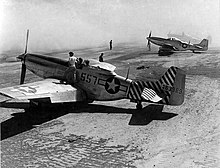| 458th Tactical Fighter Squadron | |
|---|---|
 | |
| Active | 1944–1945; 1953–1959 |
| Country | |
| Branch | |
| Role | Fighter |
| Engagements | Pacific Ocean Theater[1] |
| Decorations | Distinguished Unit Citation[1] |
| Insignia | |
| 458th Strategic Fighter Squadron emblem[note 1][1] |  |
The 458th Tactical Fighter Squadron is an inactive United States Air Force unit. It was last assigned to the 506th Tactical Fighter Wing at Tinker Air Force Base, Oklahoma, where it was inactivated on 1 April 1959.
History
[edit]World War II
[edit]
Trained in the continental United States, Oct 1944 – Feb 1945. Moved to western Pacific Ocean in spring of 1945. Escorted Boeing B-29 Superfortress bombers in raids against Japan, and attacked targets such as enemy airfields, May-Aug 1945.
Cold War
[edit]Between 1953 and 1959 the unit trained for a variety of tactical air missions. Frequently deployed for training exercises, some of them overseas.
Lineage
[edit]- Constituted as the 458th Fighter Squadron, Single Engine on 5 October 1944
- Activated on 21 October 1944
- Inactivated on 16 December 1945
- Redesignated 458th Strategic Fighter Squadron on 20 November 1952
- Activated on 20 January 1953
- Redesignated 458th Fighter-Day Squadron on 1 July 1957
- Redesignated 458th Fighter-Bomber Squadron on 1 January 1958
- Redesignated 458th Tactical Fighter Squadron on 1 July 1958
- Inactivated on 1 April 1959[1]
Assignments
[edit]- 506th Fighter Group, 21 October 1944 – 16 December 1945
- 506th Strategic Fighter Wing (later 506th Fighter-Day Wing, 506th Fighter-Bomber Wing, 506th Tactical Fighter Wing), 20 January 1953 – 1 April 1959[1]
Stations
[edit]- Lakeland Army Air Field, Florida, 21 October 1944 – 16 February 1945
- North Field, Iwo Jima, 24 April – 3 December 1945
- Camp Anza, California, 15–16 December 1945
- Dow Air Force Base, Maine, 20 January 1953
- Tinker Air Force Base, Oklahoma, 20 March 1955 – 1 April 1959[1]
Aircraft
[edit]- North American P-51 Mustang, 1944-1945
- Republic F-84 Thunderjet, 1953-1957
- North American F-100 Super Sabre, 1957-1958[1]
References
[edit]Notes
[edit]- Explanatory notes
- ^ Approved 14 April 1954. Based on World War II emblem. Watkins, p.46
- Citations
Bibliography
[edit]![]() This article incorporates public domain material from the Air Force Historical Research Agency
This article incorporates public domain material from the Air Force Historical Research Agency
- Maurer, Maurer, ed. (1983) [1961]. Air Force Combat Units of World War II (PDF) (reprint ed.). Washington, DC: Office of Air Force History. ISBN 0-912799-02-1. LCCN 61060979. Retrieved 17 December 2016.
- Maurer, Maurer, ed. (1982) [1969]. Combat Squadrons of the Air Force, World War II (PDF) (reprint ed.). Washington, DC: Office of Air Force History. ISBN 0-405-12194-6. LCCN 70605402. OCLC 72556.
- Ravenstein, Charles A. (1984). Air Force Combat Wings, Lineage & Honors Histories 1947-1977 (PDF). Washington, DC: Office of Air Force History. ISBN 0-912799-12-9. Retrieved 17 December 2016.
- Watkins, Robert A. (2017). Insignia and Aircraft Markings of the U.S. Army Air Force In World War II. Vol. VI, China-Burma-India & The Western Pacific. Atglen,PA: Shiffer Publishing, Ltd. ISBN 978-0-7643-5273-7.
Well, that’s interesting to know that Psilotum nudum are known as whisk ferns. Psilotum nudum is the commoner species of the two. While the P. flaccidum is a rare species and is found in the tropical islands. Both the species are usually epiphytic in habit and grow upon tree ferns. These species may also be terrestrial and grow in humus or in the crevices of the rocks.
View the detailed Guide of Psilotum nudum: Detailed Study Of Psilotum Nudum (Whisk Fern), Classification, Anatomy, Reproduction